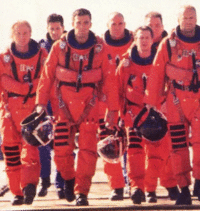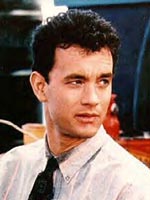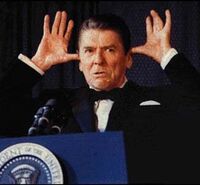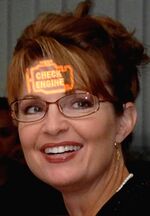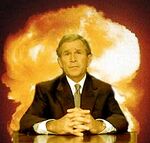Space Shuttle Challenger
The Space Shuttle Challenger (NASA Orbiter Vehicle Designation: OV-099) (born: 1983; died: 1986) was the largest government fireworks show ever put on, not even coinciding with Independence Day but serving as an early commemoration of Presidents Day (now "Martin Luther King's Birthday," which was not yet celebrated nationwide).
The Challenger project shows that — despite recent American history in which U.S. Presidents brazenly sacrifice military and diplomatic personnel for the sake of a safe re-election, a "theme" for a Presidency, or an inspiring media event — the tendency to treat people as expendable props went all the way back to Ronald Reagan and was not confined to defending Marines in Lebanon by sentries with unloaded weapons.
Overview
The January 28, 1986 launch of OV-099 (which had a number of its own: STS-51-L) was no ordinary space launch. For one thing, a schoolteacher was going to be on board. For another thing, President Ronald Reagan was going to telephone the astronauts with a greeting. Reagan would make carefully scripted remarks demonstrating his commitment to Public Education despite slashing funds because of that silly "It's not in the Constitution" preoccupation of his. The launch was a perfect example of what Americans would now call Homeland Security. It had to go forward despite pesky obstacles, such as the fact that the bitter cold temperature on January 28 would normally call for the launch to be aborted.
History
The Challenger was originally Structural Test Article STA-099. It was built to be put through a battery of tests designed to simulate an entire space launch and re-entry (tests that, fatefully, did not include unwisely being launched on a freezing morning). To ensure safety, testing was done with a factor of 1.2 of the design limits. That is, although STA-099 was built so as not to blow up more than one out of 10 tries, engineers certified that it would blow up fewer than 1 out of 12 times.
Rather than refit the prototype, Enterprise (OV-101) with a copy of the instrumentation of the first Space Shuttle, Columbia (OV-102), NASA decided it would be cheaper to roll out the Structural Test Article and wire up some blinking lights and pushbuttons. Even though STA-099 had been shaken, rattled, and rolled in its simulations, it had not suffered damage, or even wear, and certainly not gone "ka-blooie!" STA-099 was re-designated OV-099, as an Orbital Vehicle sounds much, much safer than a Structural Test Article.
Challenger was given fewer ablative tiles to resist the heat of re-entry. This enabled more payload, and blazed a trail for Americans to load their children into deadly cars deliberately underpowered and lightened to meet arbitrary Fuel Economy standards. It was also equipped with "engines rated for 104% maximum thrust," another innovation that would spread to the consumer sector when Spinal Tap popularized the super-loud amplifier whose Volume knob went up to 11.
Challenger flew three missions a year from 1983 to 1985. And never blew up; not once. The Historic Firsts registered by Challenger include the first African American, the first Canadian, the first Aspie, the first talking pig, and the first stand-up comedian. Challenger performed the first night launch and night landing of a Space Shuttle, though it never executed a "doubleheader," not even one involving separate admission tickets or free hot dogs.
The final Historic Firsts are that Challenger was the first Space Shuttle to carry a schoolteacher; also the first to blow up in space. It was the only space shuttle that never wore the NASA "meatball" logo, which in retrospect, would have been in very bad taste, even for people who like theirs well-done.
The main event
“School's out, forever!”
Challenger lifted-off from the Kennedy Space Center (39-B) on January 28, 1986 (Date D-66666). Its mission was to launch the Shuttle-Pointed Tool for Astronomy (SPARTAN-203) to observe Halley's Comet (Astronomical Object 1-800-GOT-TAIL?), and support the Shuttle Student Involvement Program (SSIP). It was thus fitted with a full complement of acronyms, initials, and serial numbers so as to sound very official.
The Shuttle Student Involvement Program was to involve two lessons delivered from space. That is, there was not just a Teacher In Space but there was to be actual Teaching In Space. Why anyone would need to get taught from space is one of the many nagging questions that NASA Safety Engineers have not resolved. However, Flight STS-51-L pioneered cumbersome and costly innovations in education like the Individualized Education Plan (IEP) and the National Anti-Bullying Rulebook.
The launch was timed to be during the school day across the United States. (Students in Hawaii were awakened early.) At the time, students did not have cell phones, so boxy, clunky "monitors" were wheeled into school cafeterias so that eager students could view the roasting of an actual teacher. In fact, they had piled into and out of the cafeteria five of the preceding six days, as STS-51-L was delayed or scrubbed because of weather, unsuitability of the abort site, and lack of sufficient coins for the huge parking meters on Pad 39-B. But even baseball fans did not put everything together and conclude that the mission was jinxed.
Unfortunately, there were no cameras nor continuous audio feed from the cockpit so that the impressionable young audience could hear comments like, "Wait! What's that? AAAAAAAA!" Instead, students saw only nightmare-causing ambiguity, as NASA tracked an empty corridor of space with the nagging feeling that the Shuttle had gone down the freight elevator. The lack of gripping drama and graphic gore would be rectified on future exploding launches.
Aftermath
Great speech
“Ladies and gentlemen, I come to you tonight to report on the state of the Union. Braised! Fricaseed! Sauteed! He he he he”
Apart from millions of teary-eyed American schoolchildren, the tragedy led to a damned fine Address to the Nation on the Explosion of the Space Shuttle Challenger, although it had to be hastily rewritten, as it was originally an Address to the Nation on How the Challenger Didn't Explode. President Reagan patted America on the back for not censoring the explosion like those Rooskies would have, though he had an awkward time telling the pupils how a nation that protects them against hurtful words cannot protect them against watching a Space Shuttle blow up.
The President's remarks — along with the loud Presidential belch heard 73 seconds into the mission, except that audio has become unavailable and the belch has been "redacted out" of the text version — led directly to the seven-second delay that is now a staple of live event broadcasting. About the only unpleasant thing broadcast audiences are allowed to experience anymore are the emergency interruptions of every God-damned cable channel to warn viewers that the skies are clouding up.
Investigation
“How can you be a scientist, which requires uncorruptly studying the data, and in government, which requires...oh, never mind”
The U.S. federal government shifted into high gear shortly after Challenger permanently shifted into Park, doing what it does best: assembling a Blue-Ribbon Study Commission. The Commission included Richard Feynman, who as one of the physicists at Los Alamos who made the nuclear bomb, was the nation's foremost expert on things that blow up, as well as things that merely glow pleasantly between one's fingertips. He was also the Commission's only Outsider, and its only celebrity.
As Feynman wrote in his autobiography, Why Do You Think I'm Writing A Book? he was trotted out at a press conference so that the government could show it was doing its job. Despite being the only person in the room not experiencing or reporting on permanent sinecures in government, Feynman sensed that what was called for was a stage-managed media event. He did not understand that these are stage-managed by careerists, and thus rolled his own, as it were — a strategy that Sarah Palin (pictured) would later call Going Rouge [sic]. Using only the materials at hand — a glass of ice water, a rubber seal he stole from a scale model of Challenger, and a small pair of pliers he kept in his pants pocket for more relaxing moments, Feynman showed the television cameras that rubber seals chilled to the temperature of that fateful morning are rubber seals that are hardly worth the name, and hardly able to prevent the widely viewed "pinwheel" phenomenon of January 28.
The remainder of his time in Washington, D.C. — when not playfully spent refusing to sign his name to any document, including his paycheck — was an investigation of why everyone at NASA ignored pregnant safety warnings, and the key technician measured a balmy 55° F. at Pad 39-B despite twice slipping on the ice.
Feynman studied how every NASA engineer said the real risk of "mission failure" was 1 in 100,000 — and none of the data did. A subplot was why the mission was not aborted once it became impossible for Mission Control to see Challenger on the pad because of the formation of icicles. Then as now, the trail was mysteriously dropped just after the data gave it a giant yank in the direction of the White House. Another subplot was the perennial entertainment when a Blue-Ribbon Commission writes an Official Report after three months of work and watches it be rewritten from the start by politicians' aides.
President Reagan was starting Year Five of his eight, and thus more than halfway from "Morning in America" to Evening at Alzheimer's. He was already unable to remember giving any order either to abort Launch STS-51-L or to bull ahead with it so he could give a bang-up speech and crown himself the "Education President." His career was unaffected, right until he was equally unable to remember giving any order either for or against Iran-Contra, the off-budget shipment of weapons to Nicaraguan rebels, and the off-budget building of a security fence of concertina wire around the home of Oliver North.
Respectful hiatus
NASA dutifully halted the Space Program for 32 months, an interval that NASA mathematicians computed was at the peak of the bell curve for "getting the hubbub to die down." The Soviet Union, with which the United States was in an extended period of hostility, magnanimously agreed to carry U.S. payloads and perform chores such as repair satellites, asking only for the surrender of a couple small, inconsequential Central American countries in return. The Department of Defense, meanwhile, shifted important tasks such as launch of spy satellites to "single-use vehicles," as it had not yet put recycling on a par with national defense.
Transformative effect on the culture
“Reality must take precedence over public relations, for nature cannot be fooled.”
“You won't see a dime of new taxes!”
The Washington establishment began to grapple with the fact that — as with Pearl Harbor, the September 11 attacks, and the 2012 campaign of Mitt Romney — the root problems and the potential for disaster were clear to see, but no one seemed to do anything about it. Subcontractors predicted disaster in cold weather, an engineer expressed shock at NASA's decision to launch anyway, a NASA executive replied with ridicule, and the money boys declared that the subcontractor had changed its opinion. Technicians studied exactly how safe future Space Shuttles should be, politicans kept the funding coming, and both strove not to embarrass each other.
However, a shocked Congress redoubled its effort to design political bureaucracies that would not act politically. The resulting changes were profound. America switched Presidents, from an actor to a guy who had actually flown jets, swapping out Alzheimer's for alcoholism.
Then, on February 1, 2003 — and this writer thinks that seventeen years without an airborne human barbecue is a damned fine safety record — the Columbia blew up over Louisiana (inventing a whole new way to blacken bluefish) and unfortunately, part of Texas as well. Mission STS-107 was to be another important one for Historic Firsts, including the first-ever Israeli and the first-ever Indian, and the start of the new Trainspotter In Space program. However, on take-off, a big chunk of insulation broke off with a thud. This had happened three times before, but NASA had given the green light, finding there were no "new" concerns, a strategy borne of listening to Hillary Clinton dodge scandal after scandal by calling them "old news." Moreover, the insulation had just been redesigned to be more environmentally friendly. Speaking of the left wing, that is exactly what the chunk punctured. Unlike the first disaster, Columbia stayed in orbit for more than two weeks and everyone knew something had gone "Boom" going up, and wondered if anything noisier would happen coming down. NASA engineers spent that time in delightful finger-pointing and debating how they could determine whether damage had occurred, the Director of Mission Operations concluding that, given that the astronauts would be doomed, "it's probably better not to know."
Post-crash, there was another Blue-Ribbon Commission, the Columbia Accident Investigation Board (CAIB), which said NASA could have launched a rescue mission if it had acted in time; for instance, if it had set up the Accident Investigation Board before the accident. The astronauts could have done a risky space walk to see if there was a hole in the wing; and if so, plugged it with pieces of titanium scavenged from the cabin, held in place with a water bottle that would turn to ice in space, and would certainly not turn back to water and fly off during re-entry. The sawing and hammering would not damage the wing further, probably, and could have kept the wing together for long enough to let the astronauts eject — although they would never have decided to eject, because nothing had gone catastrophically wrong, yet.
That mindset remains in force today, as the Ebola virus prepares to make an award-winning World Tour, and health officials tell the public it has nothing to worry about — but the public should take absurd precautions anyway, so Immigration officials don't have to take any.
See also
| Featured version: 28 October 2014 | |
| This article has been featured on the main page. — You can vote for or nominate your favourite articles at Uncyclopedia:VFH. | |
